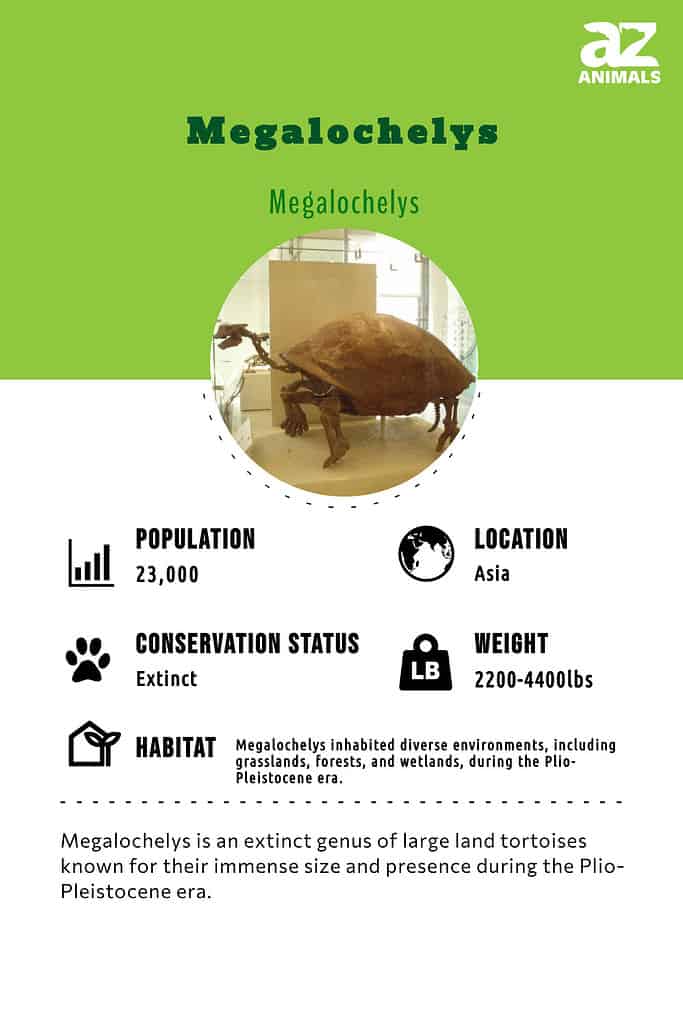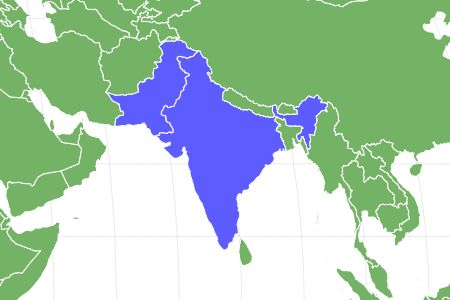Advertisement
Megalochelys Scientific Classification
- Kingdom
- Animalia
- Phylum
- Chordata
- Class
- Reptilia
- Order
- Testudines
- Family
- Testudinidae
- Genus
- cryptodiran tortoises
- Scientific Name
- Megalochelys
Read our Complete Guide to Classification of Animals.
Megalochelys Conservation Status
Megalochelys Facts
- Diet
- Omnivore
View all of the Megalochelys images!

The Megalochelys was a successful genus of giant tortoise that lived in Southeast Asia from the Miocene (about 5 million years ago) till the Pleistocene epoch (about 10,000 years ago). It is similar in anatomy to the Galapagos giant tortoise. However, it was significantly bigger. Standing at up to 2m in height, Megalochelys is considered the biggest land tortoise on record.
Description and Size
Megalochelys is an extinct genus of tortoises that lived from the Miocene into the Pliocene epoch. It was a cryptodidian tortoise. This means it belongs to a group of tortoises that typically lower their neck and pull their heads into their shells rather than folding them sideways under the shell.
The name is Megalochelys means “great turtle,” which is fitting considering the fact that this tortoise is one of the largest of any of the known testudines. One species of Megalochelys, the Megalochelys atlas, is the largest tortoise ever known. It had a shell length of more than 2 m (6.6 ft) and an estimated total length of 2.7 m (8.9 ft). The tortoise stood at an approximate height of 1.8 m (5.9 ft).
The weight estimate of this tortoise species varies considerably. According to the highest estimates, Megalochelys tortoises probably weighed up to 4,000 kg (8,800 lb). However, more conservative estimates put the mass at about 1,000 to 2,000 kg (2,200 to 4,400 lb).
Even with this estimate, Megalochelys tortoises are still the largest known land tortoises. Like many modern tortoises. The Megalochelys walked on four elephantine feet, built to support its massive weight.
Evolution and Origins
The largest land tortoise, known as Megalochelys sivalensis, was initially identified in the Plio-Pleistocene era in Siwalik, India. It is recognized as a significant species in terms of size and is renowned for its immense stature among land-dwelling tortoises.
The extinction of the genus is believed to be linked to the presence of Homo erectus. There is evidence suggesting that the arrival of Homo erectus in certain regions coincided with staggered extinctions on islands, indicating a potential causal relationship.
Furthermore, signs of exploitation by Homo erectus provide further support for their involvement in the decline of the genus.
According to scientists, the initial colonization of the Galapagos Islands by tortoises occurred approximately 2-3 million years ago. These tortoises traveled a distance of 600 miles from the South American coast, most likely by drifting on vegetation rafts or through their own means. Remarkably, they were already sizable creatures prior to reaching the Galapagos Islands.
Diet

Marvel at the incredible size of the Megalochelys.
©Chanice from Brooklyn, CC BY 2.0, via Wikimedia Commons – License
The Megalochelys was most likely an herbivore. Scientists came to this conclusion since most of the related members of the family, Testudinidae, are also herbivorous. Their diet most likely consisted predominantly of dried leaves on the forest floor. It probably fed on leafy flowering plants as well.
Habitat
Megalochelys is best known from the outer mountain range of the Himalayas known as the Siwaliks. The tortoise’s range covered parts of Western India and Pakistan. The range probably extended west as far as Europe and all the way to Indonesia in the East.
The Siwaliks are the youngest part of the Himalayan mountain range. During the Miocene, when this tortoise thrived, it was a warm and humid location with a strong monsoon season. This means it must have had an abundance of leafy flowering vegetation, which the giant tortoise could eat.
Threats And Predators
Given the massive size of this tortoise, it would have been formidable prey for any predator to take on. That is until humans arrived on the scene. Prior to the arrival of humans, the Megalochelys was a successful genus that was well-distributed across various environments, especially in Southeast Asia. The genus had at least 4 recognized species from the Late Pliocene to the Early Pleistocene. Because it was slow and didn’t have much in terms of defenses, it would have been relatively easy for humans to hunt.
Discoveries and Fossils – Where It was Found
Paleontologists discovered the first fossils of the Megalochelys as far back as 1844. It was found in Late Miocene to Early Pleistocene deposits in the Siwalik Hills of India in the outer mountain range of the Himalayas. Hugh Falconer and Captain Proby Thomas Cautley assigned the name; Megalochelys sivalensis, which means “The mega turtle from the Siwalik Hills,” to this fossil. However, they later withdrew the name and replaced it with the name “Colossochelys atlas, which translates as “The colossal turtle that held up the world.”
The timing of the giant turtle’s discovery came at a controversial time in reptile paleontology. Early authors preferred to classify the tortoise in the genus Testudo given its similarities to modern species. However, later authors preferred to place it in the Geochelone genus. In more recent revisions, scientists reverted to the original choices, and the genus name Megalochelys was chosen as the official one. The species name Sivalensis was dropped for the atlas because the latter had a more detailed description.
Extinction – When Did They Die Out?
Turtles as a group made up a large portion of the diet of early humans, and there are indications that the Megalochelys suffered the same fate as well. The disappearance of these giant tortoises coincided with the arrival of Home Erectus on the islands they lived on. Humans practically hunted them to extinction by the end of the Pleistocene epoch. However, a few of them persisted on some isolated islands until the Middle Pleistocene.
Similar Animals to The Megalochelys
Similar animals to the Megalochelys include:
- Archelon: This is an extinct genus of marine turtles that lived during the Late Cretaceous. It was about 5 m (16 ft) long and weighed up to 2,200 kg (4,900 lb), making it the largest marine turtle on record.
- Protostega: This is an extinct genus of sea turtles that lived during the Cretaceous. Scientists consider the Protostega the second-largest marine turtle.
- Centrochelys: This is a genus of tortoise considered the closest living relative of the Megalochelys.
Megalochelys FAQs (Frequently Asked Questions)
Why Is Megalochelys Extinct?
Scientists think the genus most likely went extinct due to the arrival of early humans (Home Erectus). Equipped with tools and greater intelligence, the early human settlers found a way to work around the tough shells of the Megalochelys and hunted them to extinction.
When Did Megalochelys Go Extinct?
The Megalochelys lived from the Miocene (about 5 million years ago) to the early Pleistocene. However, some populations probably survived until the middle Pleistocene, about 10,000 years ago.
How Big was Megalochelys?
Megalochelys stood at approximately 1.8m in height. It had a shell length of about 2m (6.6ft) and a total length of 2.7m (8.9ft). While weight estimates for this giant turtle varied, it probably weighed between 1,000 to 2,000 kg (2,200 to 4,400 lb)
Thank you for reading! Have some feedback for us? Contact the AZ Animals editorial team.
Sources
- Prehistoric Wildlife, Available here: http://www.prehistoric-wildlife.com/species/m/megalochelys.html
- Reptilis, Available here: https://reptilis.net/2016/05/08/t-u-r-t-l-e-power-part-4-the-little-known-paleobiology-of-the-worlds-largest-tortoise/
- Prehistoric Fauna, Available here: https://prehistoric-fauna.com/Megalochelys
- Wikipedia, Available here: https://en.wikipedia.org/wiki/Megalochelys

















